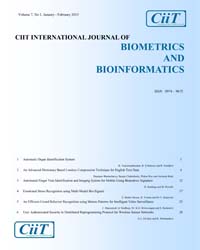Fingerprint Liveness Detection
Subscribe/Renew Journal
The use of fingerprint sensors become common and it is accepted all over world. However, fingerprint sensors are susceptible to spoofing using artificial materials or in worst case to the dismembered fingers. Fake fingerprints have shown to fool most commercial fingerprint systems. In this work, static software based programming approach is proposed in which only one single image features are required. The combination of low-level gradient features from Speeded-up Robust Features (SURF), pyramid extension of the Histograms of Oriented Gradient (PHOG) and surface features from Gabor Wavelet is used by adding all features. The features gained from these algorithms of a single image equally perform well on different fingerprint sensors. We remove these components from a solitary fingerprint image to beat the problems faced in dynamic software based programming approaches which requires user co-operation with hardware and longer computational time. Test examination done on LivDet 2011 data gives a normal Equal Error Rate (EER) of 0.1 which is good as compared to LivDet 2011 competition winner.
Keywords

Abstract Views: 254

PDF Views: 0



